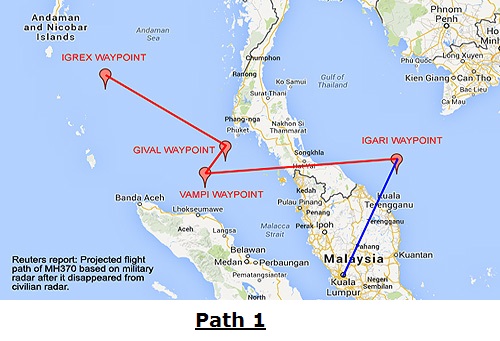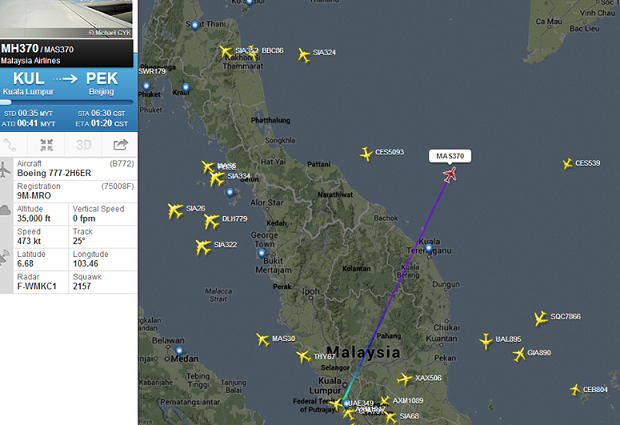Did the pilots try to land at three airports, one after another?
By Jacob K Philip
With the announcement made by Najiv Razak, the premier of Malaysia, that “flight MH370 ended in the southern Indian Ocean”, let us hope the prolonged suffering of the dear ones of the people aboard the flight would find a definite closure.
Because, most of the hijack and other related conspiracy theories were in fact giving the family members a false sense of hope.
When it was only common sense to conclude by the end of first week of the missing of the aircraft that the plane and its passengers were no longer alive, Nations, especially Malaysia, seemed to be stupefied by the avalanche of theories, counter theories, (false)leads, analysis and suggestions.
So the greatest significance of Najiv Razak’s statement, though severely criticized by many as hastily and without sufficient proof, is in its conclusive nature:
The plane and all its passengers are lost in Indian Ocean. That means a crash.
The investigations of all the past air crashes had proved one point irrespective of the widely varying nature of the tragedies: Crashes never are caused by a single event, unless they are executed by people. They would always be the ultimate conclusion of a chain or chains of events. Only when there is definite, well planned and direct human intervention that the pattern of events that had led to the ultimate crash would look simple. Like a straight line. A hijack is such a straight line. A pilot-suicide-incident is another.
The final picture drawn by a series of unintentional occurrences that had culminated into a catastrophic event will always look too complex. Just like it is in the case of MH370.
Though the very complexity is the biggest give away of an accident, it is an ideal breeding ground too- for theories to sprout up: Again like what happened these days.
And just like it is for all cascading failures, it would be wise to start the analysis at the beginning. The complexity would only have started to go up at that point.
From the full transcription of the communication between the pilots and the ATC from 00:36:30, it is evident that there were nothing abnormal about MH370 till 01:07:00. Though it was suspected otherwise, it was later proven that the ACARS might have stopped working after the, “All right, Good Night”.
Just as it had been explained in the post published March 18, the highly erratic and seemingly complex flight path the plane followed from 1.21 to 2.40 am (as corroborated by the eyewitness accounts), indicate an on board emergency that manifested suddenly, after 1.21 AM. The U turn, the climb to 45,000 ft and drop to 20,000(if primary radar readings were exact), the zig-zag path followed- all might have been the external manifestations of the desperate attempts by the humans inside to tackle the problem.
The widely shared reasoning put forward by Mr. Chris Goodfellow, who has been a pilot for 20 years, was the only other voice along this line. He said the aircraft might have been looking for an airport to land after undergoing a massive system failure caused most probably by a fire on board.
The aircraft of course might have been looking for an airport to land. But unlike what Mr.Goodfellow had suggested, the airport MH370 so frantically was flying to might not have been Langkawi.
Langkawi, around 380 km from the eastern cost of Malaysia and located on the western side, was so distant an airport to try for an emergency landing. Actually, the distance to Kuala Lumpur airport from the east coast is less- only around 275 km.
So if MH370 was indeed was looking for airport, it would have done so for an airport at a distance less than 275 km. (The length of the runway was of not that importance. B777 could land on runways as short as 6000 ft, with a little expertise).
After reaching back the east coast, the pilots would naturally have tried to locate and land at the nearest possible airport.
And there indeed were TWO airports so close to Marang and Bachok, where the aircraft was spotted by local men that night.
1. Sultan Mahmood Airport , Kuala Terengganu ( WMKN)
2. Sultan Ismail Petra Airport (WMKC), Kota Bharu.
The distance from Marang, where the first group of eyewitnesses seen the aircraft, to Sultan Mahmood Airport, is less than 50 km. The distance from Backhok, where the second eyewitness seen the craft , to Kota Bharu airport, is just around 25 km.
The most significant fact that support this theory is the seemingly erratic path chosen by the pilot. After reaching the east cost, it simply turned north west. Eyewitness 2 at Bachok said he thought the craft was going towards the sea. Need not had been.
After an attempt to land at Sultan Mahmood Airport near Marang failed , the pilot(s) must have decided to try , Sultan Ismail Petra Airport Airport, near Bachok, roughly 150 km away. The seaward flight must’ve been to aim for the Kota Bharu airport.
The reason for aborting the landing at both the attempts is evident, though.
The operating hours of Sultan Mahmood Airport is from 7.00 AM to 10.00 PM and for Kota Bharu, it is 6.00 AM to 11.30 PM.
It of course is unlikely both the pilots were ignorant of this fact. But the situation- whatever that could be- that might have been worsening by each passing seconds, might have urged the crew to resort to this desperate measure. But without any visual indications of the runway and with no means left to communicate with the airport, MH370 would have ascended again to the gloom of the night.
If MH370 had tried to land at two airports that were known to close before 11.30 PM, the on board emergency would have been that serious, and fast escalating. So the chances are remote for the aircraft to have tried for another airport.
But, if the location where the crash occurred was indeed Indian Ocean, the aircraft might have crossed the Peninsular Malaysia. That is, again a U turn after trying to land at Kota Bharu Airport. If MH370 indeed had flown towards the western coast, that might have been to try for the third time, to land.
Which would have been the target airport this time around? A big airport, not too far from Kota Bharu and one with night landing facilities. The nearest airport that match the requirements was Penang International Airport (WMKP). The runway (4/22 ) length is 3352 m. The airport functions round the clock. The distance from Bachok (or Kota Bharu Airport) was less than 230 km. (To Kuala Lumpur, the distance would have been around 340 km).
Only after the CVR and DFDR are recovered, these assumptions can be proved, of course. And for the relatives of the 239 people who were aboard the flight, the answer to ‘how’ matter so little. Even then, picking up the thread of reason, however feeble and slender it is, from among the misleading myriads of facts, fiction and hearsay, is always worth the attempt.







